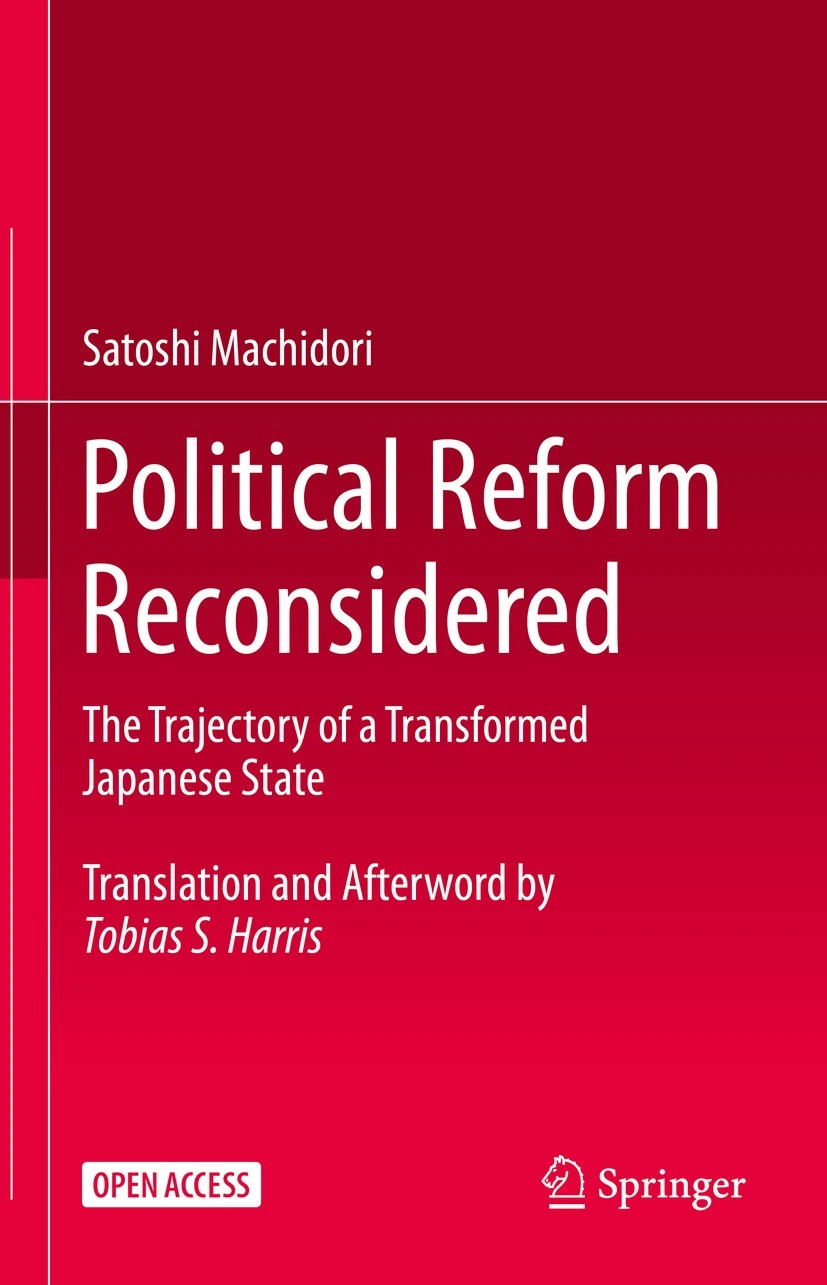One of the reasons why I did not write as many posts here last year as I might have wished is that I was busy with a side project that I can now share. I was fortunate to be invited to translate into English a 2020 book by Machidori Satoshi, a political scientist at Kyoto University. In this book, published in English under the title Political Reform Reconsidered: The Trajectory of a Transformed Japanese State by Springer, Machidori provides a thorough review of the political reforms of the Heisei era, including electoral reform, administrative reform, central bank reform, judicial reform, and local government reform. It is a convincing argument that Japanese democracy has changed quite substantially over the past thirty years, but also that these changes have had some unanticipated consequences that have not necessarily been for the better (some of which were made clear during the Covid-19 panic). Professor Machidori’s work on the intellectual origins of the political reform movement is also phenomenal.
I have long been deeply interested in this subject, and I am grateful that I was able to help bring this book to an English-speaking audience. Fortunately, the ebook — both epub and pdf — is available as an open access book here. Print copies will be available for sale in April.
Finally, I thought I would reprint the short afterword I wrote for this book, which outlines some of the main themes and connects this book to some of my own work.
Shortly after I began working on the translation of this book, the Japanese political world was rocked by the assassination of former prime minister Abe Shinzō during a routine campaign event in Nara prefecture. Abe’s assassination, and the state funeral held thereafter in September 2022, prompted a wide-reaching debate on Abe’s legacy. Much of this debate focused on his achievements in foreign or economic policy or nationalism and his views on Japan’s history.
But any discussion of Abe’s legacy is incomplete without considering his role in the transformation of the Japanese state over the course of the Heisei era. Abe’s record-long second premiership was the apotheosis of a quarter century of political reforms that fundamentally transformed the Japanese state and Japanese democracy. And in this book, Professor Satoshi Machidori provides a comprehensive look at how reformers articulated and achieved this transformation.
Professor Machidori provides a thorough intellectual history and narrative account of a truly momentous period of change in Japanese politics, starting with the reform of the electoral system for Japan’s House of Representatives in the early 1990s, and continuing through reforms of the bureaucracy, the prime minister’s office and the other institutions of Japan’s“core executive,” macroeconomic policymaking institutions, the judicial system, and center-local relations. Despite popular accounts of Japan’s political dysfunction during the “Lost Decades” of the Heisei period, Professor Machidori convincingly shows that the Heisei period—what he and others refer to as the“Heisei Democracy,” harkening back to the liberalizing“ Taisho democracy” during the Taisho period in the early twentieth century—was actually a period of tremendous innovation in how Japan is governed.
Indeed, although Abe was only a junior lawmaker when the bulk of the political reforms were articulated and implemented, it is difficult to appreciate the significance of his tenure without appreciating the political reforms of the 1990s. His surprising comeback in 2012, for example, was a perfect demonstration of what political reformers had hoped to achieve through electoral reform, as Abe, in the wilderness after his resignation from the premiership in 2007, and the Liberal Democratic Party, in opposition after its defeat by the Democratic Party of Japan in 2009, articulated new policies to challenge the DPJ and win a new electoral mandate. Back in the premiership, Abe would wield the powers afforded the prime minister by years of reform to pursue an ambitious (and often controversial) policy agenda, and, as documented by Professor Machidori, made his own contributions to the age of political reform, for example by establishing a Cabinet Personnel Bureau to manage senior bureaucratic personnel decisions and curbing the autonomy of the Cabinet Legislation Bureau.
However, at the same time, as Professor Machidori shows, the ambitions of theHeisei reformers were not fully realized. In some cases, the reforms were only partially implemented or watered down; in others, they had unanticipated consequences during the implementation process. And as Abe’s mixed legacy of policy achievements shows, transforming the Japanese state could not guarantee that Japan’s leaders would be able to overcome the political and economic challenges that reformers had argued made institutional change necessary in the first place. In other words, the Heisei Democracy showed that institutional reform—remarkably wide-reaching institutional reform—is in fact possible in an advanced industrial democracy. But it also showed that institutional reform is no panacea for the problems that advanced industrial democracies face in the twenty-first century. Therefore, this is an important contribution not only to our understanding of contemporary Japanese politics. It also is an impressive account of how institutional change can occur—notwithstanding the many obstacles and veto points in advanced industrial democracies—and of the limits of reform. It was a privilege to have the opportunity to prepare an English translation ofProfessor Machidori’s book, so that English-speaking scholars may also benefit from his insights.
I cannot recommend this book strongly enough not only for anyone interested in Japanese politics, but also in how institutional reform works in developed democracies.
As a reminder, while at the moment I do not plan to shift to a subscription model, Substack has introduced the option of “pledging,” indicating a willingness to subscribe if I were to shift to subscriptions. If you would be willing to pay for a subscription, it would be helpful if you could press the “pledge your support” button on the upper right of the page. I will not turn on subscriptions without notice, but I would like to gauge how much interest there might be.





Great stuff. Thank you!
thank youi.